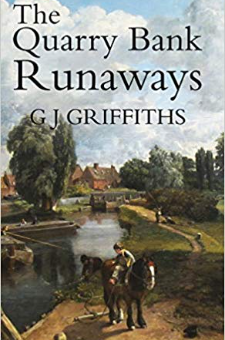 About The Quarry Bank Runaways: Revised Edition (Quarry Bank Tales) by G J Griffiths:
About The Quarry Bank Runaways: Revised Edition (Quarry Bank Tales) by G J Griffiths:
“Child apprentices in very many cotton mills continued to be treated like slaves well after the Slave Trade Acts of the 19th century.” “Pauper child apprentices from workhouses were not even paid after working 12 hour days and for 5 or 6 days a week, mill owners counted the profit!” In the early 19th century, when it was the policy of many of the poorhouses and workhouses to deter paupers from applying by making the conditions inside harsh and unpleasant, two boys set out on a journey to Hackney Workhouse in London. Their starting point was in the pleasant Cheshire countryside, where they were apprenticed to the cotton mill built by Samuel Greg in 1784. Children as young as 9 would be employed there, as scavengers, piecers, mule doffers or can tenters. These jobs could be just as unpleasant and difficult for a poor child as those we may have heard of, such as chimney sweeps and match girls. Quarry Bank Mill was some 200 miles north of London and the boys had to sneak out unnoticed and then attempt to walk all the way. It was likely that these enterprising travellers took advantage of the drovers’ roads and the newly developed “motorways” of the times – the canals. Perhaps they were lucky enough some days to hitch a lift; their general direction of travel taking them to Beartown, the Potteries, Dunstable Downs and eventually to London. Whatever challenges they encountered along the way archive evidence shows that they made it. Runaway apprentices had become a problem for society during the years of the Industrial Revolution – so what had prompted Thomas and Joseph to do such a hazardous thing? What happened to them on their long journey? Did they receive any help? Or were they chased relentlessly wherever they ran, since what they were doing was illegal in the eyes of the authorities? This is the story of their adventure and it concludes with the events in the Middlesex courthouse, known then as the Old Sessions.
Buy the book:
Author Bio:
G J Griffiths is a retired science teacher, with some early working experience of the photographic industry, who greatly enjoys being a grandad. Born in the UK, he enjoys reading most genres of fiction, such as sci-fi, crime/detective thrillers, historical and wildlife stories. Non-fiction reading mainly includes scientific or historical books. Walking in the English, Scottish or Welsh countryside with binoculars, ready for bird-watching or other wildlife is a particular pleasure. Seeing badgers and otters in the wild recently was an exciting first. His first novel was FALLEN HERO. The SO WHAT! series of three books followed and these are all focussed around the fictitious Birch Green High School. They include: book 1, SO WHAT! STORIES OR WHATEVER!; book 2, SO WHAT’S NEXT!; and book 3, SO WHAT DO I DO?. Each book is quite different in its overall context, e.g., a collection of the teachers’ experiences; the creation of a school nature corner; and arson, fraud and murder investigated by Detective Shantra, an ex-pupil from BGHS! More recent works include poetry: DIZZYRAMBIC IMAGININGS; two illustrated children’s sci-fi stories about ant-sized aliens, ANTS IN SPACE and THEY’RE RECYCLING ALIENS; and this historical fiction based upon real characters from the Industrial Revolution period, called THE QUARRY BANK RUNAWAYS. If you enjoy reading one of G J Griffiths’ books, please share your enjoyment with other readers and post a review of it on Amazon, etc. This is very helpful for new writers and he would be pleased to hear from you on the comments page at his website: https://www.gjgriffithswriter.com